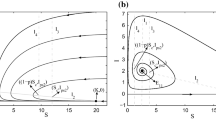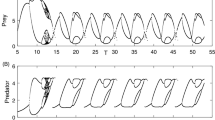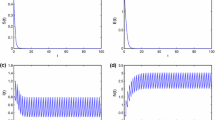Abstract
Two impulsive models of integrated pest management (IPM) strategies are proposed, one with fixed intervention times and the other with these unfixed. The first model allows natural enemies to survive but under some conditions may lead to extinction of the pest. We use a simple prey-dependent consumption model with fixed impulsive effects and show that there exists a globally stable pesteradication periodic solution when the impulsive period is less than certain critical values. The effects of pest resistance to pesticides are also studied. The second model is constructed in the light of IPM practice such that when the pest population reaches the economic injury level (EIL), a combination of biological, cultural, and chemical tactics that reduce pests to tolerable levels is invoked. Using analytical methods, we show that there exists an orbitally asymptotically stable periodic solution with a maximum value no larger than the given Economic Threshold (ET). The complete expression for this periodic solution is given and the ET is evaluated for given parameters.We also show that in some cases control costs can be reduced by replacing IPM interventions at unfixed times with periodic interventions. Further, we show that small perturbations of the system do not affect the existence and stability of the periodic solution. Thus, we provide the first demonstration using mathematical models that an IPM strategy is more effective than classical control methods.
Similar content being viewed by others
References
Arlian, L.G., Neal, J.S., Vyszenki-Moher, D.L., 1999. Reducing relative humidity to control the house dust mite Dermatophagoides farinae. J. Allergy Clin. Immunol. 104, 852–856.
Bainov, D.D., Simeonov, P.S., 1989. Systems with Impulse Effect, Theory and Applications. Ellis Harwood Series in Mathematics and its Applications, Ellis Harwood, Chichester.
Bainov, D.D., Simeonov, P.S., 1993. Impulsive Differential Equations: Periodic Solutions and Applications. Pitman Monographs and Surveys in Pure and Applied Mathematics, vol. 66.
Barclay, H.J., 1982. Models for pest control using predator release, habitat management and pesticide release in combination. J. Appl. Ecol. 19, 337–348.
Chellaboina, V.S., Bhat, S.P., Haddad, W.M., 2003. An invariance principle for nonlinear hybrid and impulsive dynamical systems. Nonlinear Anal. TMA 53, 527–550.
Corless, R.M., Gonnet, G.H., Hare, D.E.G., Jeffrey, D.J., Knuth, D.E., 1996. On the Lambert W function. Adv. Comput. Math. 5, 329–359.
Flint, M.L. (Ed.), 1987. Integrated pest management for walnuts. University of California Statewide Integrated Pest Management Project, Division of Agriculture and Natural Resources, 2nd edn, publication 3270. University of California, Oakland, CA, p. 3641.
Grasman, J., Van Herwaarden, O.A., Hemerik, L., Van Lenteren, J.C., 2001. A two-component model of host-parasitoid interactions: determination of the size of inundative releases of parasitoids in biological pest control. Math. Biosci. 169, 207–216.
Greathead, D.J., 1992. Natural enemies of tropical locusts and grasshoppers: their impact and potential as biological control agents. In: Lomer, C.J., Prior, C. (Eds.), Biological Control of Locusts and Grasshoppers. C.A.B. International, Wallingford, UK, pp. 105–121.
Grebogi, C., Ott, E., Yorke, J.A., 1983. Fractal basin boundaries, long-lived chaotic transients and unstable pair bifurcation. Phys. Rev. Lett. 50, 935–943.
Hastings, A., Higgins, K., 1994. Persistence of transitions in spatially structured ecological models. Science 263, 1133–1137.
Kaul, S., 1990. On impulsive semidynamical systems. J. Math. Anal. Appl. 150, 120–128.
Lakshmikantham, V., Bainov, D.D., Simeonov, P.S., 1989. Theory of Impulsive Differential Equations. World Scientific Series in Modern Mathematics, vol. 6. World Scientific, Singapore.
Lotka, A.J., 1920. Undamped oscillations derived from the law of mass action. J. Am. Chem. Soc. 42, 1595–1599.
Løvik, R.M.M., Gardner, P.I., 1998. Allergy. (Suppl.), Munksgaard, Copenhagen.
Matveev, A.S., Savkin, A.V., 2000. Qualitative Theory of Hybrid Dynamical Systems. Birkhäuser, Basel.
Nevada Agricultural Statistics Service, 1997. Nevada Agricultural Statistics 1996–1997. p. 20.
Nåsell, I., 2001. Extinction and quasi-stationarity in the Verhulst logistic model. J. Theor. Biol. 211, 11–27.
Parker, F.D., 1971. Management of pest populations by manipulating densities of both host and parasites through periodic releases. In: Huffaker, C.B. (Ed.), Biological Control. Plenum Press, New York.
Roberts, M.G., Kao, R.R., 1998. The dynamics of an infectious disease in a population with birth pulses. Math. Biosci. 149, 23–36.
Tang, S.Y., Chen, L.S., 2002. Density-dependent birth rate, birth pulses and their population dynamic consequences. J. Math. Biol. 64, 169–184.
Tang, S.Y., Chen, L.S., 2003. Multiple attractors in stage-structured population models with birth pulses. Bull. Math. Biol. 65, 479–495.
Tang, S.Y., Chen, L.S., 2004. The effect of seasonal harvesting on stage-structured population models. J. Math. Biol. 48, 357–374.
Tang, S.Y., Cheke, R.A., 2004. State-dependent impulsive models of integrated pest management (IPM) strategies and their dynamic consequences. J. Math. Biol. (in press).
Van den Bosch, R., 1978. The Pesticide Conspiracy. Doubleday & Co, Garden City, NY.
Van Lenteren, J.C., 1987. Environmental manipulation advantageous to natural enemies of pests. In: Delucchi, V. (Ed.), Integrated Pest Management. Parasitis, Geneva, pp. 123–166.
Van Lenteren, J.C., 1995. Integrated pest management in protected crops. In: Dent, D. (Ed.), Integrated Pest Management. Chapman & Hall, London, pp. 311–320.
Van Lenteren, J.C., 2000. Measures of success in biological control of arthropods by augmentation of natural enemies. In: Wratten, S., Gurr, G. (Eds.), Measures of Success in Biological Control. Kluwer Academic Publishers, Dordrecht, pp. 77–89.
Van Lenteren, J.C., Woets, J., 1988. Biological and integrated pest control in greenhouses. Ann. Rev. Ent. 33, 239–250.
Volterra, V., 1931. Variations and fluctuations of a number of individuals in animal species living together, translation. In: Chapman, R.N. (Ed.), Animal Ecology. McGraw-Hill, New York, pp. 409–448.
Waldvogel, J., 1983. The period in the Volterra-Lotka predator-prey model. SIAM J. Numer. Anal. 20, 1264–1272.
Waldvogel, J., 1986. The period in the Volterra-Lotka system is monotonic. J. Math. Anal. Appl. 114, 178–184.
Xiao, Y.N., Van Den Bosch, F., 2003. The dynamics of an eco-epidemic model with biological control. Ecol. Modelling 168, 203–214.
Author information
Authors and Affiliations
Corresponding author
Rights and permissions
About this article
Cite this article
Tang, S., Xiao, Y., Chen, L. et al. Integrated pest management models and their dynamical behaviour. Bull. Math. Biol. 67, 115–135 (2005). https://doi.org/10.1016/j.bulm.2004.06.005
Received:
Accepted:
Issue Date:
DOI: https://doi.org/10.1016/j.bulm.2004.06.005




